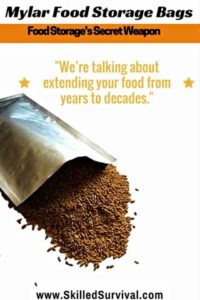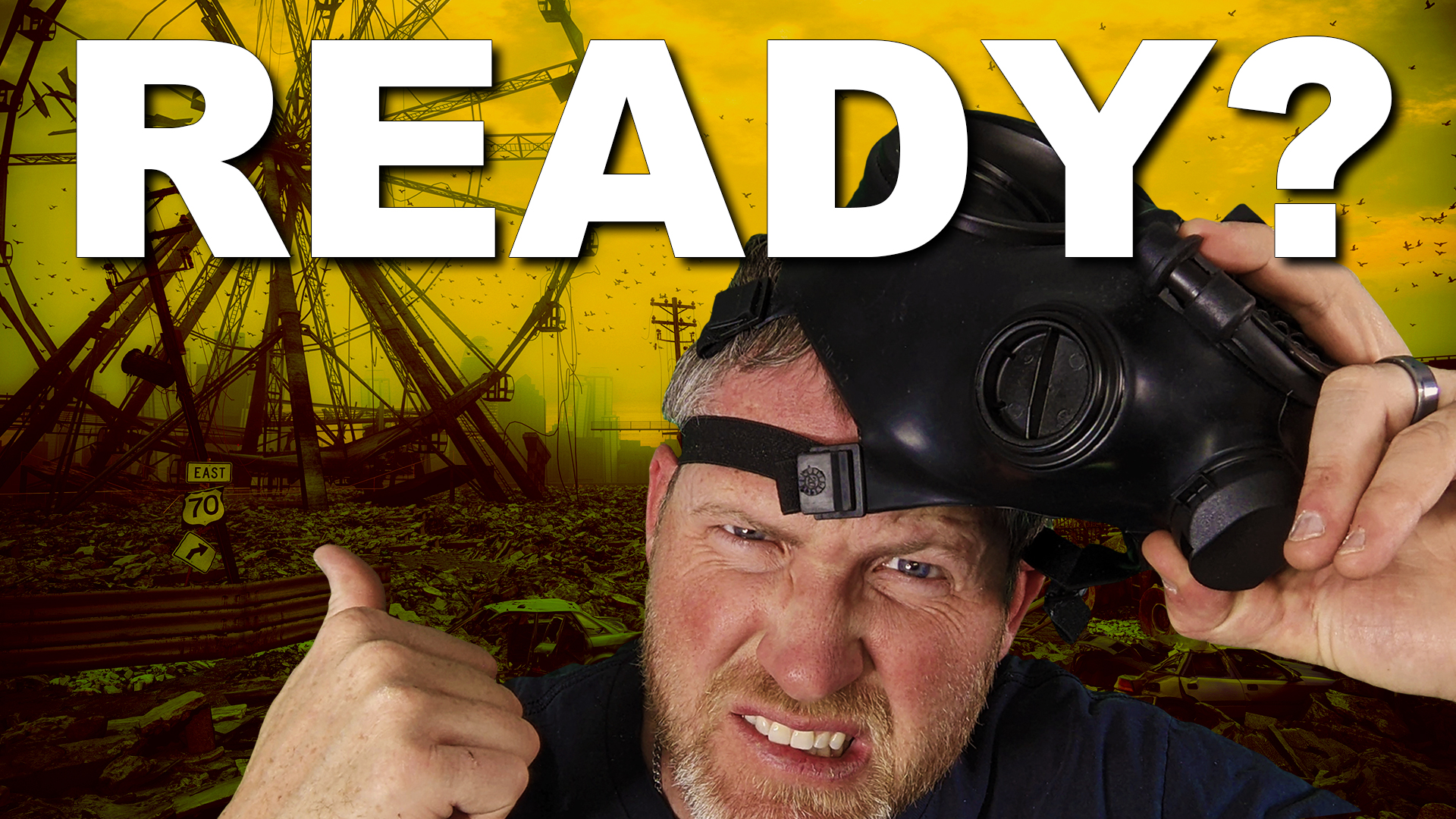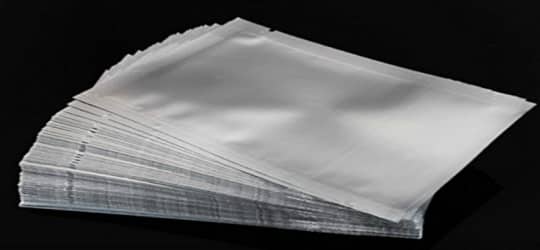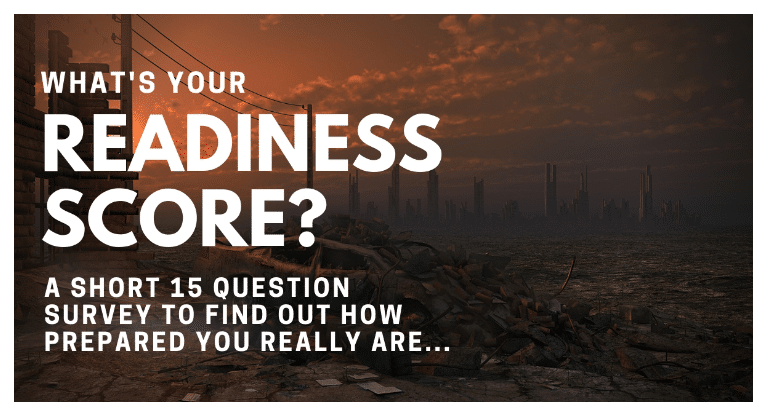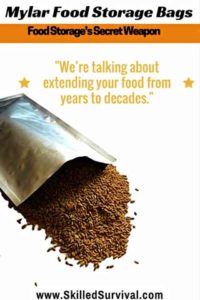
They turn the chore of “food storage” into a simple, easy, and dare I say fun, way to extend your food storage shelf life.
We’re talking about extending your food from years to decades.
OK, maybe I’m weird, but that’s exciting to me!
So what makes Mylar bags so good?
And why should you use them instead of just zip locks or food-saver bags for your emergency food stock?
By the time you finish reading this article, we will answer those questions and more.
That’s why today I’ll be covering the following mylar bag topics:
- What Is Mylar Anyway?
- Why Use Mylar For Food Storage
- How To Use Mylar Bags For Food Storage
- Mylar Bags Biggest Weakness = Rodents
- Add Oxygen Absorbers / Desiccants
- How To Seal Your Food With Mylar Bags
- DIY Food Storage Organization Tips
- Mylar Food Storage Action Plan
**Note: If you want our top recommendations, feel free to SKIP AHEAD HERE.
Are You Ready For The Tough Times Ahead? Take My 60 Sec Quiz To See If You’re Part Of ‘The Fragile Masses’ Or Not… Start Quiz Now!
What Is Mylar Anyway?
Mylar was invented by the DuPont Chemical Company in the 1950s. Simply, it’s a polyester film made from stretched polyethylene terephthalate (try saying that 5 times fast)!
It’s extremely light, flexible, and thin. But it’s also very durable and strong. That’s why you find it being used in high atmospheric helium balloons, solar filters, emergency space blankets, and insulators.
The manufacturing process is highly technical, so we’ll just go ahead and skip that section, but the bottom line is this stuff is amazing and ideal for your long-term food storage.
As A Way To Introduce You To Skilled Survival, We’re Giving Away Our Family First Food Planning Guide. Click Here To Get Your FREE Copy Of It.
Why Use Mylar Bags For Food Storage?
What you need to know is that Mylar bags are ideal for food storage due to their high tensile strength, flexible material, and isolating barrier properties. Or in layman’s terms, Mylar bags are strong, light, and tight.
Strong, so you can fill them and seal them, without worrying about ripping due to the weight.
Light and flexible, allowing the bags to conform to the food items and to collapse when removing oxygen (more on this later).
Tight, so once sealed they will isolate the product inside from the outside. This isolation allows you to control oxygen content, humidity, and light exposure. And the key to having your food stockpile last decades is to remove as much oxygen, moisture, and light as possible.
Mylar bags are the secret weapon of long-term food storage. No other food storage bag solution comes close to competing with the properties provided by Mylar.
That’s why most commercially available survival food kits use mylar pouches as well.
Using Mylar Bags for Food Storage
As A Way To Introduce You To Skilled Survival, We’re Giving Away Our #78 Item Complete Prepper Checklist. Click Here To Get Your FREE Copy Of It.
How To Use Mylar Bags For Your Food Stockpile
The first step to using Mylar bags for food storage starts with purchasing the right Mylar bags.
There are many sizes and thicknesses available. To keep things simple, I recommend you buy just two sizes of Mylar bags – large and small.
For the smaller size stick with 1-gallon bag sizes. They are perfect for your smaller food items that you don’t want to store in bulk amounts. Food items such as spices, baking powders, salts, dehydrated meats, and fruits.
For larger bulk grains such as rice, beans, wheat, etc. you’ll want a larger size bag and the 5-gallon size is perfect for these. 5-gallons is a large volume of food but not too heavy. Plus 5-gallon bags pair perfectly with 5-gallon buckets, which as we’ll discuss shortly, adds a nice advantage.
As far as thickness goes, the typical range of options is 3.5 miles up to 7 mils. The higher the thickness, the better the Mylar bag is at keeping out moisture and light.
Unfortunately, the thicker, the more expensive.
So you’ll need to decide what mil thickness is right for you. I recommend you stay away from the 3.5 mil bags. I’ve seen some 3.5 mil Mylar bags where you can see light being able to penetrate the bag.
Light penetration is not what you want.
So I caution you NOT to go with the cheap 3.5 Mylar. You should focus on protecting your most important investment (i.e. your food stockpile) by using at least 4.3 mils.
Different Sizes and Thicknesses of Mylar Bags
As A Way To Introduce You To Skilled Survival, We’re Giving Away Our Family First Food Planning Guide. Click Here To Get Your FREE Copy Of It.
Mylar Bags Biggest Weakness = Rodents
The great thing about using 5-gallon Mylar bags is you can use them in conjunction with 5-gallon food-grade buckets with lids. So you fill and seal the 5-gallon Mylar bag and then put this bag into a protective 5-gallon bucket.
Keeping rodents out of your food is important to protect your investment.
These critters chew through walls, so the only way to protect your bulk foods from these persistent rodents is to put your Mylar bags into thick hard plastic buckets. Because they will chew straight through unprotected Mylar with ease.
I also highly recommend you purchase new food-grade buckets. You never want to store your food in buckets not designed for food storage.
Food-grade buckets ensure that the material makeup of the bucket itself doesn’t contain harmful chemicals or dyes that can leach into your dry foods and grains.
If you decide to purchase used 5-gallon food-grade buckets be certain they were never used to store paints, fuels, or oils in the past. Just because they look clean doesn’t mean they weren’t used to storing harmful chemicals in the past.
These stored oils over time will seep into the material makeup of the buckets, which again can contaminate your food if stored in them.
Don’t risk your family’s health just to save a couple of bucks. Invest in new food-grade 5-gallon buckets with lids.
Mice vs. Mylar
As A Way To Introduce You To Skilled Survival, We’re Giving Away Our Family First Food Planning Guide. Click Here To Get Your FREE Copy Of It.
Add Oxygen Absorbers / Desiccant
Now before we seal the Mylar bags, it’s important that you add oxygen absorbers. The oxygen absorbers do exactly what it sounds like; they absorb oxygen.
So the idea is to add the right number of oxygen absorbers to your Mylar bag BEFORE you seal them. Then once you seal the bag, the oxygen absorber will start pulling the oxygen out of the air.
Using oxygen absorbers is important since oxygen is one of the elements that significantly reduce your food’s shelf life.
However, you need to figure out the right amount of oxygen absorbers to use. If you don’t add enough, you’ll leave oxygen to feed any mold growth. But if you add too much, then you’re just needlessly wasting money.
You can normally find oxygen absorbers in 50, 100, 300, 500, 1000, 1500, and 2000 cc sizes.
So now you need to figure out how many of these to add to different-size bags.
Figuring this out can get technical if you want to use equations, but I hate math. So instead I use simple math to get close and round up to be safe. Here’s how to do this:
Selecting the Proper Oxygen Absorber Size
The bottom line is, I’d rather err on the side of too many oxygen absorbers are cheap food stockpile insurance.
You can get a pack of one hundred, 100 cc absorbers for about $10 (or 10 cents per 100 cc). So cheap!
You can also use desiccants instead of oxygen absorbers they cost a bit more but the best ones can be reused. Here’s an article about desiccants.
As A Way To Introduce You To Skilled Survival, We’re Giving Away Our #78 Item Complete Prepper Checklist. Click Here To Get Your FREE Copy Of It.
How To Seal Your Food With Mylar Bags
Once you have your Mylar bags, oxygen absorbers, and food, you’ll need one more item before you can start sealing, a heat source.
Proper heat equals a good seal which is essential to protecting your long-term food. If you don’t get the seal right, then your food will not last decades. So you can not afford to get this wrong.
How to Seal Mylar Bags Using Iron Vs. Flat Iron Vs. Impulse Sealer
The keys to getting an excellent Mylar bag seal are three-fold:
1 . First, you need the bag to be completely flat, 100% free of debris, and at the right temp.
If you seal your Mylar bag, and it’s not flat, you have a chance of not getting a reliable seal. Because the way the seal works is you apply heat to the Mylar, and the Mylar material begins to melt. When both sides of your bag melt, it’s able to co-mingle.
It’s a similar idea to welding metal. You melt the material until it starts to become a liquid. Unlike solids, two melted liquid materials can become one.
Then you remove the heat, and the soft melted material will go back to being a solid. This is exactly what your seal is.
So if you’re trying to get both sides of your bag to melt together, a wrinkle allows a pocket of air to enter the equation. This pocket of air will reduce the effectiveness of the seal. So even if your seal seems good initially, it will be weak at the location of the wrinkle. And over time, this weak spot may break open.
2. The second key to getting a good seal is to remove all foreign particles. Small particles of food or dust in your seal can compromise its integrity.
Having food particles in the seal reduces the Mylar-to-Mylar contact by introducing a foreign body between your seal. This is not okay.
Again, over time this weakens your seal and could ultimately compromise your food storage efforts.
3. The third seal variable for reliable seals is to control the heat.
Too much heat and you’ll melt holes in the seal. While not applying enough heat results in the Mylar bag material not completely melting.
The seal may just get sticky and act like it’s holding, but it’s not completely locked together as strong as it should be.
So if you want to ensure you control the heat for the best seal, you should invest in a Mylar bag sealer like this one.
Yes, it costs a little bit more than cheaper options such as using a clothes iron or hair straightener but we’re talking about what could end up being your greatest investment ever.
Worth every penny in my opinion.
For those who want to go the cheaper route, you can use a clothes iron or hair straightener. These will work for sealing your Mylar bags, but you may need to do some testing before assuming the seals will hold long-term.
A third solution is to use a vacuum sealer.
These devices remove excess air from your bags as well as seal them. The only problem is mylar bags are smooth while food-saver bags are dimpled. The dimples are essential for the vacuum sealer to work its magic.
With smooth Mylar bags, the vacuum function won’t work.
But there is a workaround. This video shows you how you can successfully use your vacuum sealer on your smooth Mylar bags.
Vacuum Seal Bags, Problem Solved!
So if you have a vacuum sealer this is the best way to seal your Mylar bags.
If you don’t own one yet, then it’s a fantastic food storage tool. You can use it for all your frozen meats as well as your Mylar bag storage. Win, win.
As A Way To Introduce You To Skilled Survival, We’re Giving Away Our Family First Food Planning Guide. Click Here To Get Your FREE Copy Of It.
DIY Food Storage Organizational Tips
Like all your preparedness efforts, you’ll want to organize everything. It’s important to know what’s in each Mylar bag or bucket without having to open it up. And you’ll also want to know the exact date you sealed the bag or bucket.
It’s important to know what’s in each Mylar bag or bucket without having to open it up. And you’ll also want to know the exact date you sealed the bag or bucket.
The easiest way to accomplish this is by using a sharpie pen. Mylar bags are easy to write on with a sharpie marker. However, they can smudge if you don’t let them dry.
So my favorite option is to use sticky labels. I use a labeler to help keep all my emergency preparedness tasks organized.
For example, I’ve labeled all of my home’s utilities for my family. Such as our main water shutoff valve and natural gas shut-off value. I realize I won’t always be at home, and my family needs help to know which valves are which in an emergency.
It helps me sleep a little better at night.
Another great way to keep everything organized is to add the information section of the food’s original packaging. So if it was a bag of beans with the name and ingredients just fold it up and put it on the top of the bucket between the Mylar bag and bucket seal.
That way you have all the detailed info on the product you are storing. If the product you are storing was from a box, just cut out the section of the box worth keeping and again, add it to the bucket for future reference.
Now it’s time to put it all together.
Here’s a video that wraps up the entire process using Mylar bags, 5-gallon buckets, and keeping everything organized.
Urban Survival – Long-Term Food Storage
As A Way To Introduce You To Skilled Survival, We’re Giving Away Our Family First Food Planning Guide. Click Here To Get Your FREE Copy Of It.
Mylar Food Storage Action PlanN
If this was all new to you, I bet you’re surprised how easy using Mylar bags can be. You need to invest in Mylar bags, oxygen absorbers, 5-gallon buckets, the food you plan to store, and some of your time.
Then it’s time to put it all together and start your emergency food storage plan.
- Decide which foods you want to store and buy them.
- Purchase your Mylar bags in the right sizes (1-gallon / 5-gallon).
- Make sure you have plenty of oxygen absorbers.
- Purchase a few 5-gallon food-grade plastic buckets.
- Make sure you have a heat sealing device (recommended heat sealer).
- Have your organizational tools (sharpie, labeler).
- Add ingredients, add oxygen absorbers, and seal the Mylar bags (if using buckets seal after they are filled and in the bucket).
- Store your Mylar bags in buckets in a cool, dry, safe location for maximum shelf life.
- Sleep just a little bit better at night.
Take action today because knowledge without action…is worthless.
Prepare, Adapt, and Overcome
“Just In Case” Jack
P.s. Are you ready for the tough times ahead?
Find out now by taking my short Readiness Score Quiz – it’s absolutely free.
Once complete, you’ll know exactly where you stand on the “fragile” vs.” resilient” spectrum.
So click here to start the Quiz….And don’t worry; the questions are so easy a 3rd grader could answer them.
Click on the image to begin the Quiz and find out once and for all if you’re part of “The Fragile Masses” or “The Resilient Few.”
The post Why Mylar Bags Food Storages’ Secret Weapon appeared first on Skilled Survival.


